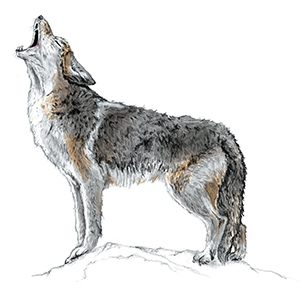Home → Fish & Wildlife → Wildlife → Species Information → Mammals → Coyote
Coyote
Canis latrans
On this page:

The Eastern coyote expanded its range north and east into Maine in the 1930s, slipping into the niche that wolves once occupied as the largest canine predator. These intelligent and adaptable animals now occupy almost every conceivable habitat type, from open agricultural country to dense forest to downtown urban areas. Despite continued human encroachment and mixed public attitudes towards coyotes, the species has maintained its numbers. Maine's winter coyote population is estimated to be between 10,000 – 12,000 coyotes.
Habitat
The female coyote digs her own den under an uprooted tree, log or thicket, or, she may use a cave, hollow log, or storm drain, or take over and enlarge another mammal's burrow. The den typically has an entrance one to two feet across, a main chamber five to 15 feet long, and a terminal chamber. Coyotes usually have several dens and move from one to the other, minimizing the risk that a den containing young will be detected. These moves also help to prevent an accumulation of fleas and other parasites, urine, droppings and food refuse. Coyotes may use the same dens year after year or make new dens in the same area.
Diet
Coyotes are opportunists, both as hunters and as scavengers. They eat small animals, including snowshoe hare, mice, rats, woodchucks, beavers, squirrels, snakes, frogs, fish, birds and carrion (animal carcasses). During summer and fall, they also eat grass, fruits and berries. They may also eat pet food, garbage, garden crops, livestock and poultry. Most hunting activity takes place at night. Undisturbed, hungry coyotes may hunt during daylight hours, and sometimes follow farm machinery, catching voles and other small prey. In winter, when snow depth restricts the movements of deer, these animals may become a larger part of a coyote's diet. Pairs of coyotes or family groups, using the relay method, pursue deer. In the spring and summer coyotes may target deer, fawns and small mammals.
Distinctive Characteristics
Coyotes are medium in size. They have pointed muzzles and long, bushy tails. Their coats are usually a mixture of tan, black, and gray, but can range from black to strawberry blond. The average Eastern adult coyote weighs 30 to 35 pounds, with males being heavier than females. Large males only rarely will exceed 45 pounds. In comparison, Western coyotes weigh 20-25 pounds on average and have a more consistent tan coat color.
Nocturnal/Diurnal
Coyotes are most active hunters during dawn and dusk hours but may have more nocturnal habits when they live in close proximity to humans to avoid conflict.
Seasonal Changes
Seasonal changes for coyotes primarily include changes in food availability and may influence their home range. During winter months when deer are more restricted because of snow depth, coyotes may take advantage of deer as a larger prey option.
Reproduction & Family Structure
A mated pair of coyotes will live, hunt and raise pups together for many years, sometimes for life. In addition to the mated pair and their offspring (family group), there are transient coyotes that do not have established territories. Breeding occurs in February. After a gestation (pregnancy) of 63 days, the female gives birth to 5-9 pups from April to May. Population density and the availability of food can affect the litter size. Both parents care for the young. Occasionally, nonbreeding siblings will assist. Pups emerge from the den in two to three weeks and begin to eat regurgitated food. Conflicts between humans and coyotes may occur at this time because the need for food increases dramatically. By six months of age, pups have permanent teeth and are nearly fully grown. At this time, female coyotes train their offspring to search for food, so it is not unusual to observe a family group. Juvenile coyotes usually disperse alone or sometimes in groups at six to eight months of age. A few juveniles may stay nearby, while others seek new territory up to fifty miles away or further. Although such crosses are rare, it is possible for coyotes to breed with domestic dogs.
Survival & Threats
Coyotes with a territory aggressively defend their territories against other coyotes. Therefore, only a limited number of coyotes can live in a given area. Human-related mortality (e.g., hunting, trapping, vehicle collisions) is the highest source of mortality for coyotes. Juvenile coyotes have higher mortality rates than adults. Coyotes are also susceptible to multiple diseases and parasites, especially when coyote densities are high. Severe disease outbreaks sometimes occur and can cause high mortality. Coyotes in captivity may live as long as 18 years. In the wild, few coyotes live more than six years.
Management & Conservation
Coyotes are managed as a furbearer in Maine, with regulated hunting and trapping seasons. In addition to season, there are rules on tagging/registration requirements, types and size of traps, trap tending, location of traps, and other restriction pertaining to hunting or trapping of coyotes. For the latest summary of laws, refer to the hunting or trapping laws and rules pages of the website.
In the early 2000s, the Department conducted a coyote study to better understand genetic origins of our coyotes. It has long been rumored that Eastern coyotes resembles wolves in appearance and may be able to hybridize with wolves. Learn more about the coyote study.
Living with Wildlife
How to Prevent or Resolve Conflicts with Coyote
Research suggests that humans create the conditions for conflict by deliberately or inadvertently providing the animals with food (such as carcasses of farm animals) or handouts, prompting young coyotes to quickly lose their fear of people. Coyotes will also become dependent on the easy food source humans have come to represent.
Learn more about how to prevent or resolve conflicts with coyote